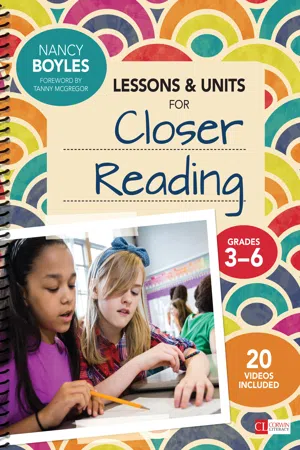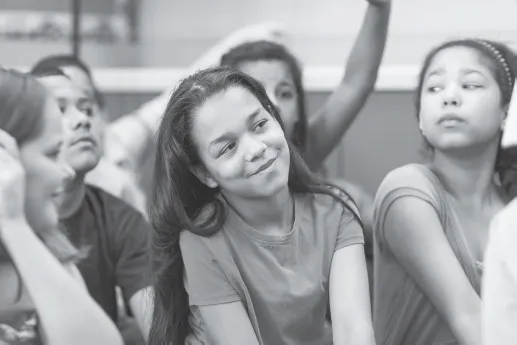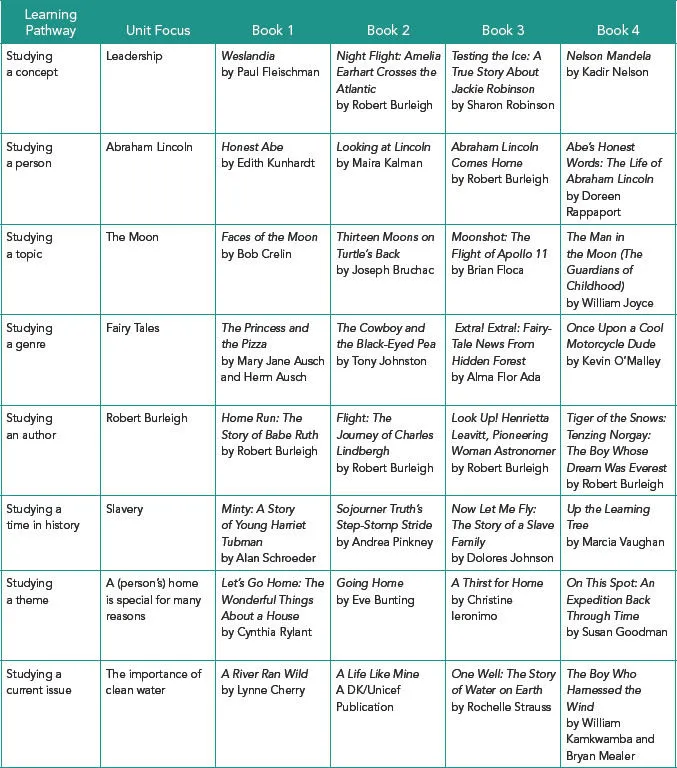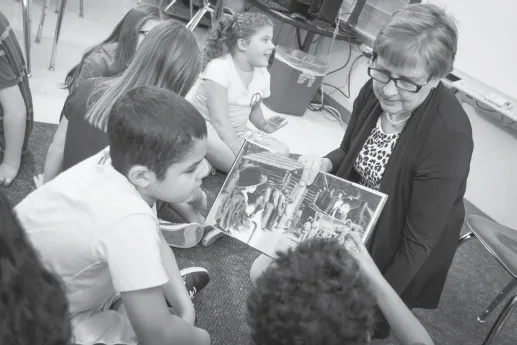
eBook - ePub
Lessons and Units for Closer Reading, Grades 3-6
Ready-to-Go Resources and Planning Tools Galore
This is a test
- 336 pages
- English
- ePUB (mobile friendly)
- Available on iOS & Android
eBook - ePub
Lessons and Units for Closer Reading, Grades 3-6
Ready-to-Go Resources and Planning Tools Galore
Book details
Book preview
Table of contents
Citations
About This Book
Ready-to-go units to ramp up close reading Want a yearlong close reading curriculum to insert in your literacy block? You’ve got it. Nancy Boyles’ Lessons & Units for Closer Reading features 32 lessons, based on readily available complex picture books and organized by eight learning pathways for approaching literature and information. Get started right away, with the help of:
- Short nonfiction articles to kick off each unit
- Assessment tasks, rubrics, planning templates, and more
- Links to 20+ instructional video segments
- Page-by-page text-dependent questions for every book
With Closer Reading, Nancy expertly delivered answers to the why and how of close reading. Now, with this phenomenal sequel, you’re treated to her playbook.
Frequently asked questions
At the moment all of our mobile-responsive ePub books are available to download via the app. Most of our PDFs are also available to download and we're working on making the final remaining ones downloadable now. Learn more here.
Both plans give you full access to the library and all of Perlego’s features. The only differences are the price and subscription period: With the annual plan you’ll save around 30% compared to 12 months on the monthly plan.
We are an online textbook subscription service, where you can get access to an entire online library for less than the price of a single book per month. With over 1 million books across 1000+ topics, we’ve got you covered! Learn more here.
Look out for the read-aloud symbol on your next book to see if you can listen to it. The read-aloud tool reads text aloud for you, highlighting the text as it is being read. You can pause it, speed it up and slow it down. Learn more here.
Yes, you can access Lessons and Units for Closer Reading, Grades 3-6 by Nancy Boyles in PDF and/or ePUB format, as well as other popular books in Education & Teaching Languages. We have over one million books available in our catalogue for you to explore.
Information
A Guide to Using the Lessons and Units

Photo courtesy of Rick Harrington Photography
Welcome to Lessons and Units for Closer Reading. As I was drafting it, I nicknamed it “the sequel” because it picks up where my previous book left off. I wrote this book in response to what teachers who had read my previous book begged to have next: close reading lessons. The first book, Closer Reading, Grades 3–6, explains the why, the what, and the how of this instructional practice. What else could teachers possibly want or need?
“We want names,” they told me, “titles of books well suited to close reading.”
“We want lessons,” they said. “We do understand what close reading is now, and we’re excited about trying it in our classrooms, but our administrators want it in place yesterday; we need help. We need a book we can use to get us started.”
Ah, I got it: Use.
So this is not a book just to read. This is a book to use. I hope you will use the thirty-two lessons included, all embedded into eight easy-to-implement units. And be sure to also use the Quick Response (QR) codes that provide access to video clips showing a close reading lesson and follow-up instruction.

In each unit, the close reading lessons connect, and this coherence helps students learn.
Photo courtesy of Rick Harrington Photography
Before we delve into the units, let’s take a quick tour of the whys and hows of their curriculum design so that you may use them effectively—and eventually create units of your own.
The Goal: Providing the Right Kind of Help
In a teacher’s world, the bottom line is always time and resources—not because teachers are unwilling to spend time outside of their school day gathering materials, planning lessons, and collecting and interpreting data but because there simply aren’t enough hours to get all of this done and get enough sleep to show up the next day with two shoes that actually match. (Yes, I’m speaking from experience here.) So when teachers began to sound the alarm for close reading lessons based on the model I presented in Closer Reading, I wanted to help by giving them what they needed—but I also knew the lessons alone weren’t quite enough, and here’s why.
In our frenzy to implement close reading almost instantaneously, there seems to be randomness happening. I visit many elementary classrooms where teachers pull their class together on a rug and teach a nice close reading lesson around a complex picture book, poem, article, or excerpt from a longer text. But when I ask teachers why they chose that particular text, and why now, they often are at a loss for words. “Isn’t it enough that I found this complex text and taught this virtuoso close reading lesson?” their expression seems to ask.
Learning Pathways, Units, and Anchor Texts

Well, yes—and no. Plunging into a sophisticated text with the intellectual rigor required for close reading is a worthy start. Teachers recognize such instruction as purposeful and focused. But do their students recognize the purpose? Do they see how the close reading skills they are honing today will work together for some important outcome? If we want to obtain the most benefit from our close reading instruction, we’ll need to help students connect the dots.
Teaching for Coherence: Why Moving From Stand-Alone Lessons to Units of Study Matters
Connecting the dots means we’ll need to do a few things differently, and I’ll explain them each briefly here, but what will be music to teachers’ ears is that each of these dot-connecting moves is embedded in all the lessons in this book.
The first thing we need to do is show intermediate grade students how the texts we use to teach them about close reading also teach them about important themes, topics, and other areas of focus. As we engage our students with these texts, for maximum motivation, we’ll also need to show that this content has coherence, “a logical, orderly, and aesthetically consistent relationship of parts” (Coherence, n.d.).
Education researchers have long noted that coherence is motivating. Bruner’s spiral curriculum (1960, p. 13) recognized the benefits of revisiting a focus area repeatedly through a sequence of instruction that moves systematically toward greater complexity, each new level building on knowledge that preceded it. More recently, Guthrie maintained that students become more motivated with “an ample supply of interesting texts that are relevant to the learning and knowledge goals being studied” (n.d., “Interesting Texts for Instruction” section). And the Common Core’s three anchor standards for reading related to “Integration of Knowledge and Ideas” sections also highlight the importance of connecting multiple texts (National Governors Association [NGA] Center for Best Practices and Council of Chief State School Officers [CCSSO], 2014). So how can we achieve this coherence and thus build young students’ motivation to read closely? We can do it by building units of study.
For starters, a unit is a “package” of literary and informational texts that all fit together in some way. That fitting together (or coherence) is the key ingredient. The texts might fit together around a concept or theme, a topic, an author, a genre, a current issue, or any other generalization. In this way, we teach with intention, and our students benefit. Why? Because they experience the unfolding of our teaching as a coherent sequence of interactions around texts and ideas. Pursuing units of study is a less haphazard, harried way to teach and learn.
The How-To’s of Teaching With Coherence
The texts used for lessons in this book were selected not just because they are compelling stories or rich informational sources but also because each one supports intentional teaching—instruction about an essential idea or understanding that intermediate grade students need to know deeply as they mature academically. Perhaps even more significant is the synergy created by studying several books together. That is why these particular texts have been integrated into units—they each have enough “heft” to merit a few weeks of examination when studied together. Now we just need to decide what kind of “great texts” will best meet our needs.

Picture books have phenomenal depth, and their compactness makes them perfect for teaching. Don’t let anyone tell you kids think they’re “babyish.” Many of the best picture books can’t even be appreciated by very young readers.
Photo courtesy of Rick Harrington Photography
Picture Books as Mentor Texts
Above all, let’s make sure that our close reading lessons are planned around texts that matter. If we’re going to spend all this time on close reading, at the end of the day, students should know not just how close reading works and how to plumb the depths of a text for meaning, but also they should have learned something useful, felt inspired, or perhaps even grown intellectually or emotionally. We should be able to answer the question: close reading for what? For this, I turn to picture books.
Bite-Size Complexity.
I have a library chock-full of picture books that offer plenty of complexity. As I turn their beautifully illustrated pages, I am amazed by the sophisticated topics they cover and important themes they embrace, the way characters and problems are developed so robustly, the eloquent language, and the varied ways authors present their stories and information. Students meet virtual friends and travel to places that could be as close as their own backyard or as far flung as a distant continent or planet. Picture books offer all the complexities we seek—typically in a mere thirty-two pages.
Visual Support for Background Knowledge.
With the support of illustrations and other graphics, these texts build the background knowledge that students often lack when they come to a complex text, especially one related to an informational topic. Open nearly any informational picture book to see what I mean: “Across its frozen seas, t...
Table of contents
- Cover
- Acknowledgements
- Acknowledgements
- Title Page
- Copyright Page
- Contents
- Foreword
- Acknowledgments
- A Guide to Using the Lessons and Units
- The Units and Lessons
- Learning Pathway How to Study a Concept What Makes Someone a Good Leader?
- Learning Pathway How to Study a Person Who Was Abraham Lincoln: Boy, Husband, Father, President?
- Learning Pathway How to Study a Topic How Do You Prefer to See the Moon—As an Astronomer, an Astronaut, a Native American, or a Storyteller?
- Learning Pathway How to Study a Genre How Many Ways Can You Tell a Fairy Tale?
- Learning Pathway How to Study an Author How Does Robert Burleigh Write Such Interesting Informational Books?
- Learning Pathway How to Study a Time in History What Choices Would You Make if You Were a Slave Child?
- Learning Pathway How to Study a Theme What Makes Home So Special?
- Learning Pathway How to Study a Current Issue What’s the Big Deal About Clean Water?
- The End of the StoryReflecting on Student Work
- References
- References
- Publisher Note